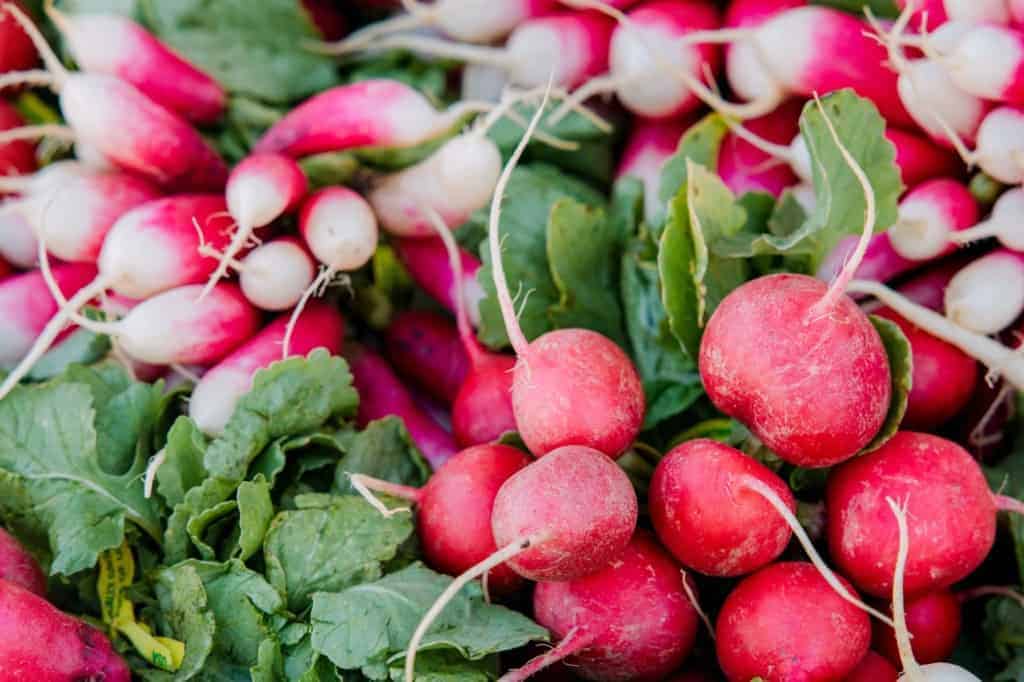Food of the Month – Spring Vegetables

Click here for a delicious Chicken and Vegetable Rice Noodle Salad recipe
The emergence of spring’s first succulent vegetables signifies a welcome transition away from the storage crops, hearty greens and meats of winter. Spring vegetables are considered the most tender of the year, because their rapid growth and new shoots do not have a chance to become “woody” prior to harvest.
Red Radishes: A peppery root vegetable which grows from seed to harvest in less than 4 weeks. The spiciness is not from capsaicin like in chiles; this heat comes from an interaction between two compounds. When crushed or cut, they interact, creating isothiocyanate, a sulfurous compound with potential health benefits. Isothiocyanate is the same compound which makes horseradish, wasabi and mustard spicy! Radishes are spiciest when grown in hot weather or inconsistently watered; in general, beneficial bioactive compound levels are higher in stressed plants. To reduce heat, soak in ice water or roast. A 2012 article from the Journal of Biotechnology and Biomedicine found radish protective against cholesterol-based gallstones.
Spring Onions: Whether called scallions or green onions, these baby onions are harvested before their bulb fully forms. Thinner specimens tend to be milder, while thicker spring onions tend to have more bite. Store wrapped in damp paper towels in the refrigerator crisper. A mainstay in Asian stir fry, spring onions are wonderful fresh or even grilled whole, as is often done with Carne Asada.
Asparagus: A perennial vegetable, asparagus will produce once-yearly harvests for up to 20 years! To avoid chewing on woody stalks, do not cut asparagus bunches with a knife, instead, bend each stalk near the base until it snaps, discard woody bases. Asparagus is high in the nutrients vitamin K and folate, as well as soluble fiber. Avoid cooking too long in water as nutrition will be leached from the vegetable. Choose firm, hydrated stalks with compact tips. Roasting and grilling are classic techniques used for cooking this beloved vegetable.
Sulphur-containing compounds which break down in the GI tract are responsible for urine odor which can be detected for 15 minutes to 14 hours after consumption.
Snap Peas: A cross between snow peas and shelling peas brought to market in the 1970s, this legume is popular for having an edible pod. A cup of snap peas provides 3 grams protein, 2 mg iron, and a very good source of dietary fiber, Vitamin A and Vitamin C! Enjoy snap peas fresh or lightly cooked to preserve their desirable texture.
 Amber Phillips, MS, RD is a registered dietitian at Island Hospital. She has a Master’s degree in nutrition from Bastyr University in Kenmore, WA and a Bachelor’s degree in biology from Metropolitan State University, St. Paul, MN. Phillips has a keen interest in community education. “Nutrition advice can be confusing and sometimes conflicting,” says Phillips. “My role as a dietitian is to follow the latest research and make it easy to understand for my patients and the public.” To schedule an appointment with Phillips, call (360) 299-1300 x2567.
Amber Phillips, MS, RD is a registered dietitian at Island Hospital. She has a Master’s degree in nutrition from Bastyr University in Kenmore, WA and a Bachelor’s degree in biology from Metropolitan State University, St. Paul, MN. Phillips has a keen interest in community education. “Nutrition advice can be confusing and sometimes conflicting,” says Phillips. “My role as a dietitian is to follow the latest research and make it easy to understand for my patients and the public.” To schedule an appointment with Phillips, call (360) 299-1300 x2567.
Published on May 13, 2021
